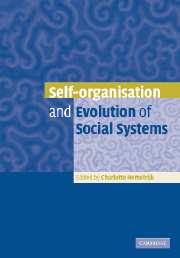Book contents
- Frontmatter
- Contents
- List of contributors
- Preface
- Introduction
- 1 From unicellular to multicellular organisation in the social amoeba Dictyostelium discoideum
- 2 Optimality of communication in self-organised social behaviour
- 3 The interplay of intracolonial genotypic variance and self-organisation of dominance hierarchies in honeybees
- 4 Traffic rules of fish schools: a review of agent-based approaches
- 5 A process-oriented approach to the social behaviour of primates
- 6 Order and noise in primate societies
- 7 Self-organisation in language
- 8 Dictatorship effect of majority rule in voting in hierarchical systems
- 9 Natural selection and complex systems: a complex interaction
- 10 Interlocking of self-organisation and evolution
- Index
- References
6 - Order and noise in primate societies
Published online by Cambridge University Press: 07 December 2009
- Frontmatter
- Contents
- List of contributors
- Preface
- Introduction
- 1 From unicellular to multicellular organisation in the social amoeba Dictyostelium discoideum
- 2 Optimality of communication in self-organised social behaviour
- 3 The interplay of intracolonial genotypic variance and self-organisation of dominance hierarchies in honeybees
- 4 Traffic rules of fish schools: a review of agent-based approaches
- 5 A process-oriented approach to the social behaviour of primates
- 6 Order and noise in primate societies
- 7 Self-organisation in language
- 8 Dictatorship effect of majority rule in voting in hierarchical systems
- 9 Natural selection and complex systems: a complex interaction
- 10 Interlocking of self-organisation and evolution
- Index
- References
Summary
As students of animal societies, we claim we observe levels of organisation, networks of relationships, mating systems and demographic structures. We identify classes, matrilines and hierarchies. We consider things like parental investment, nepotistic patterns or dominance strategies. We try to explain the patterning of these behavioural characters by looking for their fitness. Hidden in such an endeavour is a common assumption among scientists: the world and its objects exist independently of any observer; scientists have to discover these objects. Such a stance is known as metaphysical realism (Putnam, 1981). In biology, this implies that we assume natural selection to act upon characters we observe. But ‘How would we know if social organizations were not adaptive?’ (Rowell, 1979). Even if we are not acquainted with philosophical thinking, we should be warned against the appearance fallacy. We are aware that the brain reconstructs reality from electrical signals transmitted by the sensorial organs. We do not perceive social organisations per se. As Ashby (1962) puts it, the organisation exists in part in the eye of the beholder. What is seen may be named sociodemographic forms, which means, sets of individuals that are distributed and behave in a structured manner (Thierry, 1994). Sociodemographic forms represent the phenomenon, the visible aspect of social organisations. If we attempt to reduce them to adaptive strategies, this may amount to attributing an adaptive function to reified structures, in other words to endowing appearances with a fitness (Thierry, 1997).
- Type
- Chapter
- Information
- Self-Organisation and Evolution of Biological and Social Systems , pp. 108 - 122Publisher: Cambridge University PressPrint publication year: 2005
References
- 2
- Cited by



